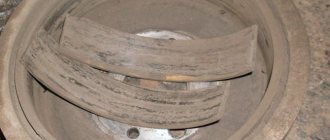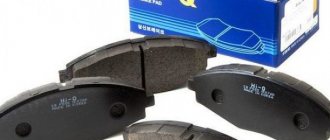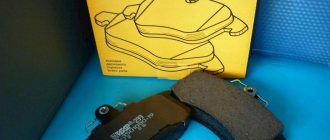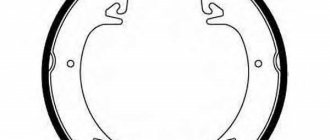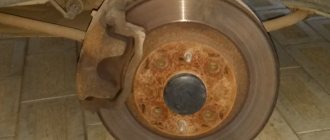The Lada Kalina, regardless of generation, uses front disc and rear drum brakes.
The process of stopping the machine is accompanied by wear of the pads, so they must be periodically replaced.
It’s easy to do it yourself, and if difficulties arise, it is recommended to watch a thematic video.
Article number and estimated cost of original front pads
The first generation Lada Kalina was equipped with brake disc pads with article numbers 21100-3501080-01 and 21100-3501080-00. Their price ranges from 460 to 500 rubles. The service life of the pads depends on the driving style and for most car owners it is 35-45 thousand km.
New brake pads have been developed for Lada Kalina 2. Their article number is 11180-3501080-00, and the price is 260-290 rubles. Consumables are not interchangeable with products for Kalina 1. Their service life can reach 60-70 thousand km, but usually replacement is required at 40 thousand km. The same pads are installed on the Lada Kalina Cross.
Brake pads 11180-3501080-00
There are pads for Lada Kalina Sport. They are installed as tuning on standard cars, but this requires replacing the caliper. Consumables have improved performance characteristics.
Factory pads produced by AvtoVAZ
As for the service life, I have no complaints here at all, in this they completely suit me. Judge for yourself, they spent 30 thousand and could have served just as long. But there are huge complaints about the quality of braking; to put it mildly, there was none at all. I remember there were several cases when it was difficult to avoid a collision in city traffic. While I pressed the brake pedal with all my might, the car continued to float without noticeable slowdown. It was after several such cases that I decided to change it, but as it turned out, I ended up with a fake.
Article number and price of recommended front brake pads for Kalina from third-party manufacturers
The brake pads installed from the factory have satisfactory quality and performance characteristics, so for replacement it is better to choose analogues from third-party manufacturers. The recommended non-original consumables listed below will ensure smooth and intense braking without any extraneous sounds.
Table - The best analogs of pads 21100-3501080-00 and 21100-3501080-01
| Manufacturer | vendor code | Estimated cost, ruble |
| Bosch | 986491700 | 1000-1200 |
| Remsa | 22100 | 450-700 |
| Road House | 222100 | 500-600 |
| Ferodo | FDB527 | 850-1000 |
| Delphi | LP551 | 660-800 |
Table - Good analogues 11180-3501080-00
| Manufacturer | Catalog number | Approximate cost, ruble |
| Profit | 50001325 | 540-650 |
| Road House | 222102 | 680-850 |
| TRW | GDB1446 | 1100-1300 |
| Ferodo | TAR527 | 540-620 |
| ATE | 13046029652 | 950-1100 |
ATE
When the above options disappeared for reasons already known to you, I decided to wander through the forums of foreign car owners, and since I am a fan of the Volvo brand, I went to their club and read what kind of pads were on these cars from the factory. And according to many owners, their front and rear brake pads came from the factory from ATE. Well, I decided that if the safest cars in the world have such brakes, then they would also be an ideal option for Kalina. And now a few words about the impressions after installation. The first few kilometers, of course, there were no special changes, since they were still new and had not gotten used to it, but then everything became just super. Now, just before the speed bump, I brake and the car stops dead in its tracks, there are no sounds even close. As for efficiency, everything is just perfect here; I have not yet seen better brakes. But I can’t say anything about their service life yet, since I’ve only driven them a little over a thousand kilometers. And one more plus after installing them - the discs again became perfectly smooth, like new, otherwise they were corrugated from old defective parts, all in grooves. As soon as I drive the first 10,000 km on the ATE, I will definitely write about the results, subscribe and follow the blog updates. Thank you for your attention!
Article number and approximate cost for rear original Kalina pads
Rear original drum pads for Lada Kalina of the first and second generation have article number 21080-3502090-01 in the case of the basic configuration. If the car is equipped with ABS, then the installed consumables come with catalog number 11180-3502090-10. The price of products ranges from 720 to 890 rubles. Replacement of pads is required every 70-90 thousand km.
Which brake pads are suitable for Lada Granta?
10 best brake pads for Lada Granta
| 1 | ATE | The best protection against counterfeiting. Effective braking |
| 2 | BREMBO | Highest coefficient of friction |
| 3 | LADA | Manufacturer's best choice |
| 4 | FINWHALE | Long service life. Does not contain asbestos |
| 5 | BOSCH | The optimum ratio of price and quality |
Article number and cost of good analogs of original rear brake pads for Lada Kalina
When stopping, the rear axle does not bear the main braking force. Therefore, a more important characteristic for drum pads is their quietness. Original consumables cannot boast of the absence of squeaks and squeaks. Because of this, car owners prefer analogues from third-party brands, the best of which are listed below.
Table - Recommended analogues 21080-3502090-01
| Pad manufacturer | Article number | Approximate price, ruble |
| Bosch | 0 986 487 813 | 900-1200 |
| LYNXauto | BS-4601 | 1000-1400 |
| TRW | GS8210 | 1050-1300 |
| Remsa | 4129.00 | 1100-1600 |
| Textar | 91037201 | 1330-1800 |
Table - Recommended alternatives for 11180-3502090-10
| Pad manufacturer | Catalog number | Approximate price, ruble |
| TRW | GS8210 | 860-1000 |
| Finwhale | VR318 | 720-800 |
| ABS | 8812 | 670-780 |
| Bosch | 986487813 | 780-950 |
| Profit | 50010240 | 550-670 |
Entry three. Brakes.
In this post we will talk about rear brakes. Not long ago I began to notice that the rear brakes began to over-braking and make rustling sounds when braking. Over-braking the rear axle in icy conditions does not cause any positive emotions, and even more so if your wife is driving. Therefore, it was decided to quickly look for the cause. When I bought the car, I promised myself and everyone around me that in the near future I would only drive, and do only the most necessary things, without fanaticism. Yeah... Figurines. The poet’s soul couldn’t stand it... A plan was immediately born in my head about what needed to be changed. Absolutely everything was replaced except the hub itself and the handbrake cables. As they say, change is change :) On the first trip after buying the car, I had a strong feeling that it was time for the rear wheel bearings to retire. As a result, the list of necessary things included: 1. Rear wheel bearings 2. Rear brake pads (preferably ATE) 3. Rear brake cylinders (preferably ATE) 4. Brake drums (only factory and nothing else)
After going to the store, I was a little puzzled by the fact that the choice of brake pads for Viburnum with ABS is very small. To be more precise, only two companies. Either the factory or NIPPON. I came home and started smoking viburnum forum. And in fact, there is no choice. And the culprit is the ABS sensor, which is visible through the brake pad. Well, in the end I decided to buy NIPPON. I went to the store and bought: 1. Rear wheel bearings SS-20 At first impressions, the bearings left positive emotions. Beautifully packaged, nut as a gift, detailed installation instructions.
2. NIPPON rear brake pads. At first I thought the company was so-so. It turned out to be a Japanese company (well, of course I don’t know if it’s Japan, but something like that). I also liked how everything was packaged, everything was beautiful, napkin, instructions, etc.
3. Rear brake cylinders ATE.
4. Brake drums factory.
On the weekend I went to the garage and got to work. The process is the simplest, so there is no point in describing it.
During the analysis, it turned out that everything feels very good, nothing is leaking anywhere, nothing is rubbing, and everything is in its place, the pads are not even worn out. The only thing was that the cylinders were a little sour, but they worked fine. What was I doing for nothing? Everything can be replaced, without any dispute about who is to blame and who is not.
I quickly changed everything and put it in place
Next I took up the bearings. I pressed it out and pressed it in without much effort or difficulty. As usual, it couldn't be done without a sledgehammer. As my uncle said, “H... what can you do without a Russian sledgehammer”
I read a lot about bleeding ABS brakes. On the Kalina forum, opinions are very divided. I'll tell you from my own experience. I pumped it the old fashioned way. WITHOUT TURNING ON THE IGNITION AND ANY OTHER MANIPULATIONS! The only thing is that I pumped it not crosswise, but counterclockwise. Starting from rear right - front right - front left - rear left. Everything has been pumped up perfectly and is working. What can I say. The brakes have become wonderful. Brakes excellent, ABS works well, no extraneous noise or excessive braking. I achieved what I wanted, and I’m very pleased with the result. Oh yes, and now I don't hear the humming bearings, which is good :)
Replacing front pads on Kalina
Instructions for replacing the front brake pads are given below.
- Jack up the car.
- Remove the front wheel.
- Turn the steering wheel to make it easier to replace the pads.
- Bend the locking plate.
- Insert a screwdriver and press in the brake piston. If this is not done at this stage, then later you will need to use a clamp.
- Unscrew the lower caliper bracket fastener.
- Open the caliper bracket.
- Remove old pads. If necessary, rearrange the anti-violin plates.
- Install the pads in their seats.
- Reassemble everything in the reverse order of removal.
- Check the operation of the brakes. A decrease in the intensity of stopping the car is associated with running in the pads
Fake production, such as AvtoVAZ
As you probably already guessed, I drove just 8,000 kilometers on these pads, after which they turned into black dust left on the disks of my Kalina. I remember I picked them up at the car market for a price of about 230 rubles. And as the seller assured me, it was exactly the original from AvtoVAZ, which I, of course, later doubted, because my factory ones went about 30,000 km and weren’t even half worn out, but I’ll tell you why I replaced them a little later. So I don’t advise anyone to buy cheap ones, especially in the car market, otherwise, in the worst case, you might end up having to replace the brake discs.
Step-by-step instructions for replacing rear pads
The algorithm for replacing rear drum pads is given below.
- Shift the gearbox to first speed.
- Remove the wheel by first jacking up the car.
- Unscrew the pins that secure the drum.
- Tap the back of the cover with a hammer using a wooden spacer. This will allow you to tear the drum out of place and remove it with loosening movements.
- Remove the cotter pin.
- Remove the lower spring that tightens the pads.
- Move the block to the side until the spacer bar leaves its seat.
- Remove the pads.
- Disconnect the handbrake lever and other parts. Replace everything with new consumables.
- Check the condition of the springs and, if necessary, replace them with new ones. To do this, you will need to purchase a special repair kit.
- Reassemble everything in the reverse order of disassembly.
- Check the brakes.
When to change the rear pads of LADA “Kalina”
The peculiarity of the LADA Kalina braking system is that when braking, the load is distributed unevenly and most of the kinetic energy is absorbed by the front brakes. Therefore, replacing the rear Kalina pads is done 2-3 times less often than the front ones. To find out when it’s time to change the pads, it’s useless to rely on the Kalina’s odometer readings. The number of kilometers a car travels between pad replacements can vary by half. The rate of their wear is influenced by many factors, some of which cannot be controlled and taken into account:
- driving style (during aggressive driving with frequent sharp acceleration and braking, the pads can wear out several times faster than during calm, smooth driving);
- quality of friction linings (counterfeits or pads from cheap brands last much less); the condition of the rear brake drums (if they have uneven wear or ellipticity, the wear rate of the pads increases greatly);
- exposure to external factors (chemicals that are sprinkled on the road surface in winter, other active substances that get on the friction linings).
Under normal conditions, the Kalina rear pads are replaced after 50-60 thousand kilometers. But you need to focus not on mileage, but on the thickness of the friction linings. If they are chipped, peeling, or become thinner than one and a half millimeters, they must be immediately replaced with new ones. Otherwise, damage to the brake drum or leakage of brake fluid may occur (if the linings are thin, the pistons may completely come out of the brake cylinders, which will cause depressurization of the circuit).
Reviews of VAZ Kalina brake pads
I skated 66,000 km on original pads. At one point I heard a heartbreaking crunch of metal, I even had to stop. I unscrewed the wheel and looked at the disc, a little scuff appeared, well, everything is clear, the pads. I went to the store and bought an average price. I don’t even remember the price to be honest, but they completely suit me. They brake perfectly, and the most important thing is that they don’t creak.
- 2017-05-19
I’ve had Rosdot EURO 5000 since 2013 (by the way, who doesn’t know Rosdot is TIIR, I don’t remember just the 275 brand), I liked the pads, sometimes they creaked in traffic jams, then the creaking went away by itself, the brakes seemed strong, but I was wrong, during normal driving, everything seems to be fine until the moment you have to urgently release the brakes, this is where they show their abilities, unfortunately, sluggish... The front does not skid, the pads float, they are very disappointing in this regard, it is dangerous to drive with such brakes.
- 2016-03-31
After reading reviews and the Internet and not finding much crime, I decided to take RosDot, price 560 rubles. They look like they were made well, they look more attractive than the original with ugly varnish or whatever. Well, after 20 thousand I want to say that it’s not ice. At first it was fine. Then they started creaking like mad. And now there is some kind of incomprehensible ass with the rear brakes.
- 2016-03-03
I decided to change all the pads in a circle in order to slightly improve the brakes on my “Muscari Sport” and get rid of the beating during hard braking (apparently the pads were overheated or something else was wrong with them). The choice of pads is now very extensive: Ferado, FINWHALE, Dafmi, TRW, ALLIED NIPPON, Sangsin brake and even Brembo! But after reading a lot of reviews and based on the previous experience of my ex-2107, I settled on the already known LYNXauto. Somewhere I came across information that the pads are actually made from Japanese materials. I placed an order through an online store. The pads work just fine, the braking is excellent, they also brake in the rain without any problems, there is no squeaking! I will continue to install them.
- 2015-12-13
I took the risk of changing the pads to Finwhale. I've owned the car since 17k (I'm the second owner)... I changed it the other day. The odometer showed 22.7k. The choice in stores is of course great... from 240 to 900 rubles for a set of front ones. a spread of 8-10 different manufacturers... including Ferrodo. Ferodo didn’t take the risk - there are just a lot of fakes... The relatives (apparently factory ones) began to terribly irritate with their creaking... but that’s not so bad... for a mileage of 5k they sharpened the discs to 1mm... and the braking was reminiscent of a slight activation of the ABS: some small, but very frequent twitching... I installed Finwhale - I immediately went for a ride around the area and tried it while the roads were clear and pedestrians were not throwing themselves under my feet... I braked in different ways, quietly and to the floor until it came to a complete stop and the ABS was activated (I managed to hit the pedal once). The sensations (I have now driven 150 km on the new ones) are completely different. They brake softer and an order of magnitude more efficiently... You don’t have to put all your weight on the brake pedal (this is taking into account a normally working vacuum brake!) in order to stop without giving up. The creaking from the pads has practically disappeared (I'm tired of mowing under a UAZ). Barely audible sometimes. The creaking is very quiet and only appears during light braking at very low speeds (in a traffic jam, for example). The car stops softly, smoothly and very predictably. There is no need to strain your leg when braking and press the pedal even harder (on the old ones you seem to stop... but the speed is still reduced a little...).
- 2015-03-29
They brake well and almost do not creak, there is a slight squeak when you slow down slightly, but rarely. By the way, the pads have a groove in the middle.
- 2014-01-30
Finval pads are 129mm long, i.e. it turns out there is a gap of 1mm on the guide, which, according to the manufacturer of the brake mechanisms, can cause a knock when driving, so I bought Quattro Freni pads with a stated length of 130, they cost pennies, if you don’t mind. It's a shame, really. The length turned out to be 129.5, well, to hell with it, it still didn’t knock, my brakes just hit when braking hard, so I decided to experiment. It's a rare crap, when braking it began to hit even harder, even at low speeds, and they began to squeak, apparently it's a matter of heating, i.e. Budget pads don't do the job.


